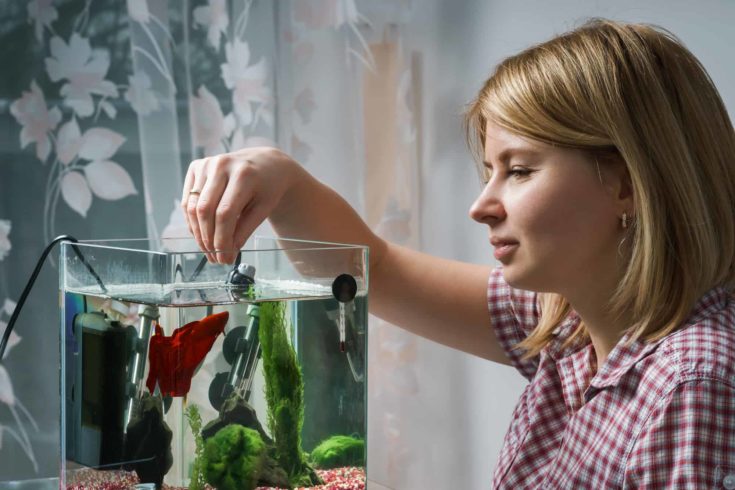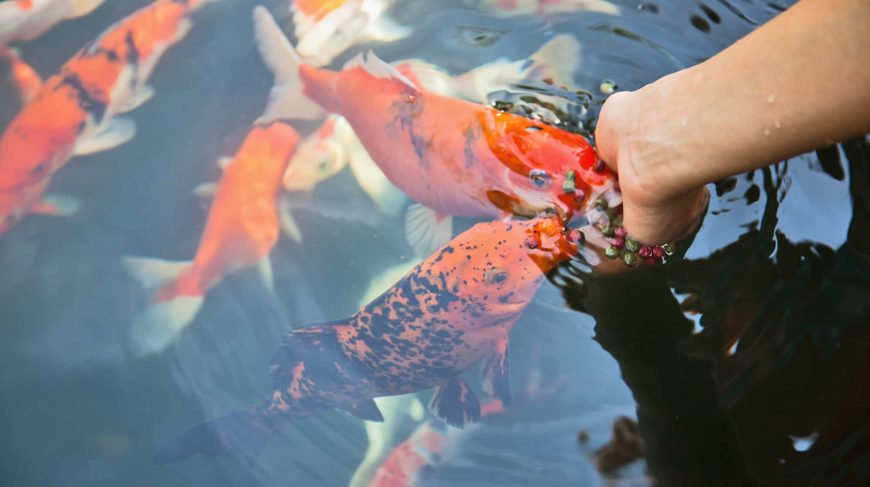Everyone loves a little variety in their diets from time-to-time, and fish are no different. Many good quality fish foods do an excellent job of meeting the nutritional needs of our underwater pets, but some of us might feel compelled to jazz up their diets with something different.
If you’ve ever found yourself wondering if there are substitutes for the fish flakes you regularly feed your fish, this article is for you!
What Are The Fish Eating Requirements?
First and foremost – let’s take a look at our key fundamental question: What do fish eat?

Fish have different dietary requirements depending on whether they are carnivorous, omnivorous, or herbivorous. In general, these are a list of nutrients fish require:
- Amino acids
- Fats
- Plant matter
In addition, the food should be easily digestible to prevent bloating, kidney infections, and ammonia pollution. Always select fish food that most closely matches the individual needs of your fish.
What Are The Alternatives To Fish Food?
When one thinks of fish food, one typically thinks of fish pellets and flakes. Most alternatives to fish pellets and flakes utilize natural raw ingredients that are wholesome and safe for fish to consume.
Usually plant or seafood based, these alternatives to fish food supply your fish with essential nutrients while satisfying the taste buds of even the pickiest eaters. Check out 6 of those alternatives in the list below!
6 Alternatives to Store-Bought Fish Food
Fresh Vegetables
If you own herbivorous or omnivorous fish, fresh vegetables can be just the thing to satisfy their hungry bellies! Here are a few of our top recommendations:
Peas
Even if you have commercial fish food on hand, peas are an excellent dietary supplement for most omnivorous fish. When given in appropriate quantities, peas provide dietary fiber, which keeps your fish’s digestive tract healthy!
The best way to feed peas to your fish is to boil them up, remove their outer skins, and break them up into tiny bite-sized pieces for your fish. Both fresh peas and frozen peas would work, but do steer clear of canned peas that contain preservatives. These chemicals might not sit well with your fish’s digestive tract.
Lettuce
If you thought the health-boosting benefits of lettuce only applies to humans, you thought wrong! Even fish benefit from the minerals and vitamins they can obtain from lettuce leaves. Species such as African Cichlids and goldfish are big fans of this leafy green.
To feed your fish, simply tear this nutritious vegetable up into tiny pieces, and place them in your aquarium. Boiling the lettuce beforehand might also make it easier to eat.
It is important to note that lettuce rots more quickly than other types of vegetables due to its large surface area and high moisture content. For that reason, you should remove uneaten lettuce from the tank after 1 hour.
Cucumber
Cucumber, zucchini, and courgettes are excellent examples of vegetables you can feed your fish. Bottom feeders such as plecos and corydoras will happily munch on slices of cucumber that have drifted to the bottom of the tank. Other fish might also be able to enjoy these crunchy treats when they are served in bite-sized pieces.
Remember to remove all seeds from these greens before serving them to your fish, as they may pose a choking hazard for your fish, or cause problems in their digestive tracts. Uneaten seeds will also pollute your tank if they are not removed.
White Fish Fillets
Carnivorous fish feed on smaller fish in the wild, and are likely to enjoy frozen fish fillets as a meaty treat from time to time. We recommend white fish as they are cost-effective and low in fat. This makes them ideal, convenient snacks you can feed to your fish in a pinch.
To feed your fish, simply defrost the white fish fillets beforehand, and break them up into manageable pieces. Here are some white fish species that are typically used for in feeding:
- Tilapia
- Cod
- Coley
We recommend steering clear of fatty or oily fish when feeding your fish. Fatty fish can be unhealthy for your fish. In addition, they can cause the formation of oil slicks on the surface of the water in your tank. While it is entirely possible to clean them up, oil slicks reduce oxygen exchange at the surface of the water and should be avoided.
Live Foods
Whether you get them fresh or frozen, live fish foods are jam-packed with nutrients that are essential to your fish’s health. Because live foods are not commercially processed, they have much higher nutritional density compared to store-bought fish flakes and pellets.
Some examples of live foods include:
- Brine Shrimp
- Daphnia
- Mosquito Larvae
- Blood Worms
Most live food sources can be purchased fresh or frozen. We will discuss the benefits and drawbacks of both options below:
Fresh Live Food
When purchased from fish stores, fresh live foods tend to be pricier than their frozen counterparts. However, many people opt to cultivate their own live food, which can be a good way of obtaining fresh live food for your fish without breaking the bank.
While fresh live food may most closely resemble the type of food fish consume in the wild, it is important to take note of the potential drawbacks. First of all, live aquarium fish foods can serve as an intermediary for disease transmission. If your food sources have been infected by a bacteria or parasite, your fish might also be affected by the disease.
Pro Tip
Another factor to consider is that fresh live food has a limited shelf life. Most live food sources only survive up to a week, which means that you’ll need to make frequent trips to the pet store. This may not be a convenient option for many people.
Frozen Live Food
One of the primary advantages of frozen fish food is that they are unlikely to introduce diseases into your tank. These protein sources are typically treated with a safe dose of radiation before frozen, eliminating all disease-causing pathogens from the fish.
In addition, frozen live foods also have a longer shelf life than their fresh counterparts. Because they are flash-frozen at peak freshness, they typically retain their nutrition and freshness until the end of their shelf lives. Stored correctly, frozen live foods will last you around 18 months.
One thing to note about frozen live foods – once they have been defrosted, they have to be used immediately. Refreezing them will produce toxic free radicals in the food, posing a danger to your fish’s health.
Hard-Boiled Egg Yolks
Egg yolks are a great source of essential proteins, making them a favorite among hobbyists seeking a nutritious substitute for fish food. They are a particular favorite among small fish, fish fry, shrimp, and livebearers.
Before serving the egg yolk to your fish, be sure to hard-boil it beforehand. Beyond the food safety-related reasons for doing so, hard-boiling also makes the egg yolk easier to consume for your fish.
Do note that egg yolk particles can make the water in your tank cloudy if overused, so be sure to feed your fish an appropriate amount.
Gel Food
If your fish enjoy taking their time with their food, it can be a challenge to keep the water in your tank clean. Leaving fish food in the water for too long can cause pellets and flakes to disintegrate, leaving a cloudy mess and causing ammonia levels to spike. On the other hand, removing uneaten food too quickly may leave your fish malnourished.
Gel fish food addresses both these problems by maintaining its form for up to 24 hours. You can opt to purchase premade gel food mixes by companies such as Repashy Ventures. Professionally formulated gel food can be used as a staple in your fish’s diet, as they are likely to meet the complete nutritional needs of your fish.
Homemade Fish Food
If you’re the type of person who enjoys a good DIY project, this one’s for you. Did you know that you can make your own fish food? Not only is this recipe incredibly easy to make, it contains quality ingredients that your fish will enjoy.
There are many recipes for homemade fish food available online, but our favorite is this no-cook recipe due its versatility and convenience. It is perfect as a treat for omnivorous fish, and can be whipped up in about half an hour!
Ingredients
- Peas – 12 ounces (oz)
- Spinach – 12 oz
- Shrimp – 2 oz
- Cod – 2 oz
- Gelatin – 1 oz
Instructions:
- Place peas, spinach, shrimp, and cod into a blender and pulse until thoroughly combined.
- In a separate container, make your gelatin mix by placing a sachet of gelatin in hot water.
- Combine the blended ingredients with the gelatin in a container with a large surface area to expedite cooling. Place the mixture into a fridge to set.
- After the mixture has set, unmold the mixture and cut the food into appropriate portions
- To store, place the cut food in a freezer and use within 12 months.
Which Common Fish Food Alternatives Should You Avoid?
Now that we’ve covered some good substitutes to store-bought fish food, it’s time to clear up some misconceptions about fish food alternatives that are safe to feed your fish.
The food alternatives are not recommended because they are either harmful, or pose no benefit to the health and well-being of your fish.
From the “try-to-avoid”s to the “absolutely-not”s, here are some common fish food alternatives you should steer clear of:
Bread
Many people feed bread to their fish because it is readily available. However, this is not recommended because bread contains wheat, yeast, and chemicals that may cause bloating and other digestive issues in your fish. These conditions are life-threatening when not addressed in a timely manner.
Bread also doesn’t contain nutrients your fish requires. Fish meet the bulk of their nutritional needs by consuming protein sources and plant-based matter. While the carbohydrates in bread can provide your fish with energy, too much of it can actually damage the guts of your fish.
The only situation where the benefits of feeding bread outweighs its harms is when starvation is the other alternative. If it will take more than 4 days for you to get healthier food options for your fish, a small amount of bread will be okay in the interim.
Dog Food
Surprising as it may seem, dog food is actually one of the most popular fish food alternatives among hobbyists. Many fish keepers swear by dog food, claiming that it helps their fish to grow to impressive sizes.
However, bigger isn’t always better. Although these fish may look large and impressive, they may suffer from health problems such as having too much visceral fat. This detracts from the goal of good husbandry, which is to raise fish that are healthy and resilient.
Meat
Although many fish are carnivorous, this does not mean that they should be fed meat. Fish should obtain most of their protein from cultured live foods, or fat-free seafood. Unfortunately, many other sources of meat such as poultry and beef contain large quantities of fat, which is unhealthy for your fish.
One exception to the rule is beef heart, which doesn’t contain as much fat as most types of meat. The little fat it does have can be easily trimmed away. Beef heart is often served shredded to carnivorous and omnivorous fish. It makes a delicious treat!
Boiled Rice/Pasta
Given their ubiquity as pantry staples, it is hardly surprising that rice and pasta are often fed to fish as a substitute for fish food in a pinch. As is the case with bread, just because fish will eat rice and pasta, doesn’t necessarily mean that it is good for them.
Rice and pasta are generally harmless in small quantities, as long as they are boiled beforehand. It is crucial to boil rice and pasta before serving it to your fish, as uncooked rice and pasta will expand in your fish’s stomach and cause bloating.
As long as your rice and pasta are cooked, you can feed them to your fish as an occasional treat. These food sources should not be used as a long-term substitute for fish food, as they do not contain the protein and plant-based nutrients required by fish.
Conclusion

Whether you’re looking to spice up the diets of your fish with a little variety, or supplement their regular diet with some alternative sources of nutrition, there is a fish food substitute for you. This range of convenient alternatives differ in nutritional composition and preparation method, but can make excellent options when fed appropriately.
What is your personal opinion on fish food substitutes? Would you give them a try? Let us know in the comments below, and tag a friend if you think they’d find this article interesting!
